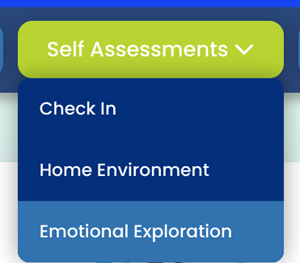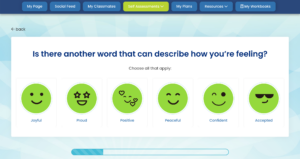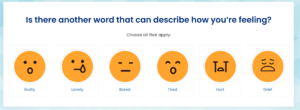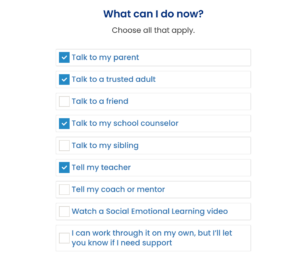Building Dreams - Emotion Exploration Self-Assessment Feature

Here’s the thing about being a human being: We have a lot of emotions. Across all of our lifetimes, we will experience a roller coaster of emotions. From grief to joy. From bravery to embarrassment. From rage to peace.
We are in a highly dysregulated time right now, and in order for us to heal as a community, we must begin with healing ourselves. Have you ever screamed at a loved one as if a volcano was erupting? There was just no stopping it. Have you witnessed someone losing it in public and think, “What on earth are they doing? How are they this upset?”
Self-regulation doesn’t happen on its own. It’s learned. It’s practiced. It’s taught. And there are some things we need to learn how to do first:

1 – Take your emotional temperature. How often do you identify how you’re feeling? Are you sure it’s accurate? We often get used to certain basic emotions like sadness, worry, anger, or happiness. But what if our feelings are more complex than that? They often are. We can hold many emotions at one time. That’s the beauty of being human. But until we can accurately identify how we’re feeling, we won’t be able to regulate and find peace. We recommend an emotion wheel.

2 – Identify your triggers. We all have them. It’s nothing to be ashamed of. We have people, memories, or even songs that can set us into a variety of emotions. We can take control of these moments when we can be proactive or “get ahead” of our reactions. Here’s the thing: We are the only ones who have been in our body. No one else has our experiences. We are unique and have unique reactions. If we are aware of our frequent triggers and reactions, we can memorize those in order to prevent them from occurring again. We recommend this article to help.

3 – Remove judgment of certain emotions. No emotion is a “bad” emotion or “good” emotion. They’re just emotions. Do some feel better than others? Sure. But they all serve an important purpose: We need them. Emotions help us to communicate with others, such as when we feel sad and need some help. They also can help us to act quickly in important situations. [1] Even if the feeling is uncomfortable, it’s important that we feel every emotion as it comes up.
 4 – Learn + practice with regulation techniques. We are all born with an emotion regulation “toolbox.” When we are babies, our only tool in the toolbox is to scream and cry. As we get older, we gain more tools to add to our toolbox. Some of those tools are adaptive, like deep breathing, taking a walk, or talking to a friend. Some of them are maladaptive, like punching a wall, passive-aggressive communication, or avoidance. It’s important to know these maladaptive tools serve a purpose: We learned they help calm our bodies down in times of stress. As we get older, it’s our responsibility to remove our maladaptive tools and “pick up” or learn healthy, adaptive tools that help ourselves and our loved ones. Learn some regulation techniques here.
4 – Learn + practice with regulation techniques. We are all born with an emotion regulation “toolbox.” When we are babies, our only tool in the toolbox is to scream and cry. As we get older, we gain more tools to add to our toolbox. Some of those tools are adaptive, like deep breathing, taking a walk, or talking to a friend. Some of them are maladaptive, like punching a wall, passive-aggressive communication, or avoidance. It’s important to know these maladaptive tools serve a purpose: We learned they help calm our bodies down in times of stress. As we get older, it’s our responsibility to remove our maladaptive tools and “pick up” or learn healthy, adaptive tools that help ourselves and our loved ones. Learn some regulation techniques here.
Did you know we have a feature in Building Dreams that helps our students “dig deeper” and identify their emotions? They can access the Emotion Exploration feature through logging into their account and completing a Check-in Assessment or at any time throughout the day by clicking on the Self Assessments tab. Emotion Exploration gives students the opportunity to walk through their emotions and triggers while prompting them through potential solutions. This feature not only helps students, but it helps their adult caretakers like their parents at home or their teacher at school to better understand them. With increased self and social awareness, we can calm our nervous systems and make the world a more peaceful place.
Copyright 2021 Fight For Life Foundation
Powered By: Mojo Up Marketing + Media

